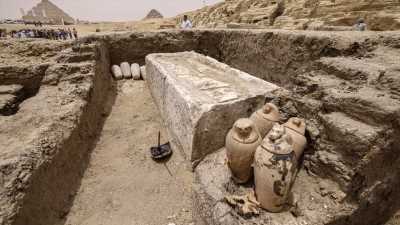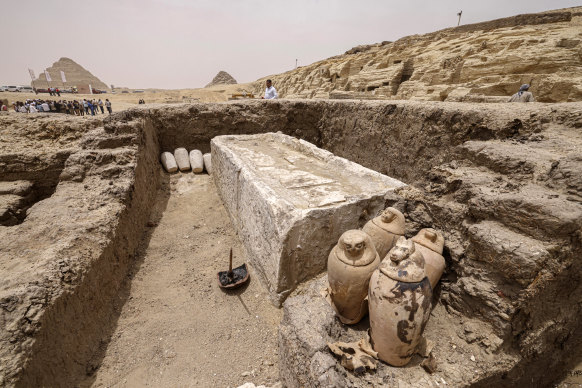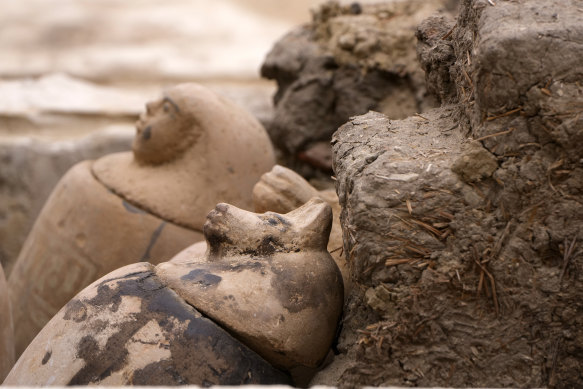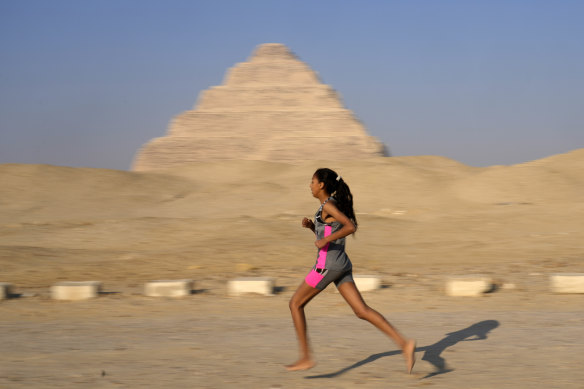Archaeologists discover biggest ever Egyptian mummification workshop
Save articles for later
Add articles to your saved list and come back to them any time.
Cairo: Egyptian archaeologists have uncovered “the largest and most complete” human and animal mummification workshop ever found at a site near Cairo.
The workshop, which dates from the 30th Dynasty and the early Ptolemaic era (4th century BC), was found near the oldest stone pyramid, Djoser’s Step Pyramid.
“Two stone beds for human embalming were found in a number of rooms. The beds were approximately two metres long and one metre wide. They were made of stone blocks and covered with a layer of mortar that sloped down to a gutter,” said Mostafa Waziri, secretary general of Egypt’s supreme council of antiquities.
Visitors tour the site in the Saqqara necropolis south of Cairo, where archaeologists unearthed two human and animal embalming workshops, where embalming beds and canopic jars were found.Credit: AFP
“The mummification beds were used to prepare the body by extracting the human organs, which were placed in canopic jars that were discovered.”
The human mummification workshop is a rectangular mud brick building divided from the inside into a number of rooms. Other mummification materials discovered included linen rolls and tools used to extract body organs.
A separate sacred animal mummification workshop is a rectangular mud, brick, and stone structure divided into rooms and halls. It contains animal burials and bronze tools for animal mummification, as well as five limestone beds recessed into the floor.
The discoveries also include two small 4400 and 3400-year-old tombs carved into the rock. They are believed to belong to high-ranking officials and priests.
Canopic jars, which were made to contain organs that were removed from the body in the process of mummification, are seen at the site of the Step Pyramid of Djoser in Saqqara.Credit: AP
Inscriptions of cultivation, hunting, and other activities were found on the walls of one of the tombs, as well as a large collection of artefacts, which included beautiful intact wooden and stone statues, and funerary objects.
The mummification process in Ancient Egypt was a complex and time-consuming procedure that could take up to 70 days. The first step was to extract the defunct’s internal organs, which were then placed in stone or ceramic jars. The body was then washed, covered in natron, a naturally absorbent carbonate mineral, and left to dry for 40 days.
A barefoot runner participates in the 10km Saqqara Pyramid Race at the site of the Step Pyramid of Djoser in Saqqara, southwest of Cairo, Egypt, in February.Credit: AP
After drying, the body was wrapped in linen bandages inscribed with spells and images of Egyptian gods. The mummy was then placed in a coffin and buried.
The Bubasteion necropolis, one of Ancient Egypt’s major burial sites, was located on the west bank of the Nile opposite Memphis. It was dedicated to Bastet, the patron goddess of cats.
The Telegraph, London
Most Viewed in World
From our partners
Source: Read Full Article




